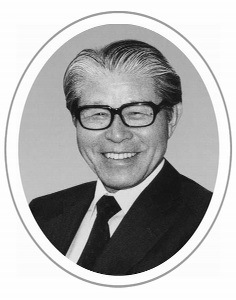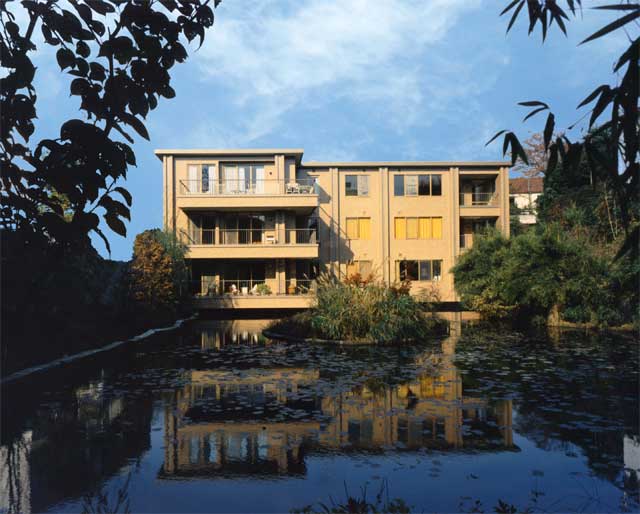
Rooftop garden and 203,204 conference room : Jiro Matsumura
BRIEF BIOGRAPHY
| 松村 二郎 (1917年2月13日~1988年2月27日) 大阪生まれ。1936年大阪商船入社。第二次大戦中タイ・バンコク支店に勤務していたが戦況が悪化、現地で造船所の建設などに携わったのが建築の最初の仕事となる。戦後日本に引き揚げ、外務省の要請に応じて終戦連絡事務局管理部長として米軍の住宅を建築することになり、アメリカ式の建築工事、設備工事を学ぶ。 1954年ホーマットホーム株式会社設立。設立の目的は、戦後荒廃した東京では住宅事情が非常に悪く特に外国人が住めるような家がほとんど無かった為設備の整った快適な住居を諸外国の人々の為に提供することであり、松村は近代的な設備と同時に伝統的な日本の魅力を建物に取り入れ、東洋と西洋を上手く融合させた家を建てるという明確なビジョンを持っていた。これらの住宅は外国人の間で非常に喜ばれ好評を博した。1963年には在日公館関係者や外資系企業役員向けに集合住宅の建築をスタートさせ、以後100棟を超える高級アパートを設計、名作ブランド「ホーマット」シリーズとして高い評価を受ける。 建築のコンセプトは、外国人が国際的な基準を備えた住宅で暮らせること、そして日本文化の伝統美を住む人たちが楽しみ、広く交流をはかることであった。そのために外部には鉄平石の塀、石畳、灯籠、池など、室内には障子や引き戸などの和のテイストを意匠に取り入れ、又緑の存在が今ほど重要視されなかった時代から自然環境との調和を考え、緑豊かな外構と屋外ライフを楽しめる屋上庭園を造った。それらの建物は長年のうちに歴史的建造物のように都心の住宅街の風景に馴染んでいる。ここで豊かな生活を楽しみ、“ホーマットに住んでいた”ことを誇りに思い、懐かしく思っている諸外国からの住人も多く、建築を通して日本文化の紹介と国際的な民間外交に尽力した。 建築分野以外では長期に亘り東京アメリカンクラブの副会長を努め、没後は永久名誉会長としてその名が残されている。また中国の研究者を招待し学費を援助したり、日米協会、日英協会、日本外国特派員協会のメンバーとして率先して国際交流に力を注いだ。 主な作品 |
| ホーマットアンバサダー(港区) | ホーマットキャピタル(港区) |
| ホーマットヒルズ(渋谷区) | ホーマットカヤ(千代田区) |
| ホーマットマジェスティ(港区) | ホーマットオリエント(千代田区) |
| ホーマットプレミア(新宿区) | ホーマットプリンス(港区) |
| ホーマットロイヤル(港区) | ホーマットシャロン(港区) |
| ホーマットバージニア(港区) | ホーマットバイカウント(港区) |
| ホーマットウエスト(港区) | 徳川ビレッジ(豊島区) |
|
この度、国際基督教大学に建設された東ヶ崎潔記念ダイアログハウスは、緑豊かなキャンパスにおいて、学問、研究の対話による交流を通じて相互理解と平和構築を図ることを目的としており、松村二郎が戦後抱いた建築の理念と合致すると考え、ここに創業者松村二郎の業績と人格に敬意を表してこの会議室と庭園に松村二郎の名前を冠名し覚えることとした。 JIRO MATSUMURA February 13, 1917 –February 27, 1988 Jiro Matsumura was born in Osaka. He joined Osaka Shosen K.K. in 1936, and was stationed in its office in Bangkok, Thailand, during the World War II. As the war intensified, he was responsible for the construction of dockyard facilities, his debut in the construction business. At the end of the war, he returned to Japan and was appointed by the Ministry of Foreign Affairs of the Japanese Government, as Director of Management for the Regional Liaison Office, and was commissioned to build houses for U.S. military personnel. This was his initiation to American style architectural design, the equipment and skills of home building. In 1954, Jiro Matsumura established Homat Homes Ltd. to provide comfortable and fully equipped residential houses for expatriates from many foreign countries. Such houses were in short supply in war devastated Tokyo. He was a visionary who embraced the challenge of blending East and West in building houses for expatriates in post war Tokyo expecting contemporary facilities and also wishing for the charm of traditional Japanese accents. He delivered both. These houses were welcomed by them, and had a good reputation. In 1963, he started to build residential apartment complexes for foreign executives, totaling more than 100 completed buildings, with a good reputation, and the brand name of "Homat" apartments. Jiro Matsumura's philosophy in building residential apartments for expatriates was to provide living space where they could enjoy comfortable living in Japan according to international standards and fully equipped with the appliances they would expect to have in their home country. On the other hand, he wanted to combine the traditional styles of beauty in Japanese culture in the houses he built, and skillfully carried out his desire to combine the two cultures, in both inside and outside elements. This was exemplified in Homat buildings outside by the use of the flagstone (Teppei-seki) for fences and walkways, Japanese stone lanterns, and small fish ponds. Inside, by paper screens and sliding doors. He also attached great importance to planting trees and shrubbery in abundance around the exterior, so that the building would be in harmony with nature. He created roof top gardens with greenery, so residents of apartments could enjoy outdoor living, which was quite an outstanding idea at the time. Not many people paid attention to the greenery surrounding their apartment building. The Homat apartments that he created fit nicely into residential areas of central Tokyo as hallmark buildings. There are many ex-Homat residents who happily remember the experience of having lived in Homat apartments during their stay in Japan. Jiro Matsumura, as a civilian diplomat and through his distinctive buildings, made an outstanding contribution in introducing Japanese culture to the international community. Besides his achievements in unique buildings, he served as Vice-Chairman of the Tokyo American Club for many years. His portrait has been placed in the Hall of Presidents as a Permanent Honorary Chairman of the Club. He was also a member of the Japan-American Society, the Japan-British society, and the Foreign Correspondents Club of Japan, and was quite active in international exchange programs, extending invitations to Chinese scholars to study in Japan with tuition assistance. Major works: |
| Homat Ambassador (Minato-ku) | Homat Capital (Minato-ku) |
| Homat Hills (Shibuya-ku) | Homat Kaya (Chiyoda-ku) |
| Homat Majesty (Minato-ku) | Homat Orient (Chiyoda-ku) |
| Homat Premier (Shinjuku-ku) | Homat Prince (Minato-ku) |
| Homat Royal (Minato-ku) | Homat Sharon (Minato-ku) |
| Homat Virginia (Minato-ku) | Homat Viscount (Minato-ku) |
| Homat West (Minato-ku) | Tokugawa Village (Toshima-ku) |
| The Kiyoshi Togasaki Memorial Dialogue House of the International Christian University has been newly constructed. It is on a campus abundant with greenery. Its purpose is to promote mutual understanding and building a foundation for peace through the interchange of dialogue in research and study. This idea is in line with philosophy and belief that Jiro Matsumura embraced after Word War II. This conference room and the garden shall bear his name and be dedicated to the memory of Jiro Matsumura and his distinguished works. |
DONORS
|
|
PHOTO
 松村 二郎 Jiro Matsumura  ホーマットプリンス Homat Prince 1974 |
